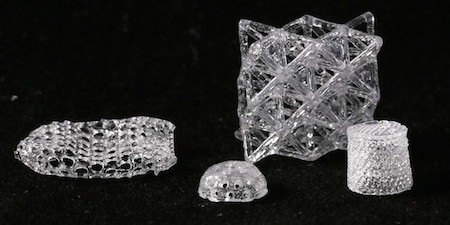Science Fiction
Dictionary
A B C D E F G H I J K L M N O P Q R S T U V W X Y Z
3D Printed Glass Uses Stereolithography Techniques

3D printed glass objects have been made by ETH Zurich researchers using a new technique based on the 1980's art of stereolithography.

(From Glass objects created with a 3D printer)
David Moore, Lorenzo Barbera, and Kunal Masania in the Complex Materials group led by ETH processor André Studart have developed a special resin that contains a plastic, and organic molecules to which glass precursors are bonded.The resin can be processed using commercially available Digital Light Processing technology. This involves irradiating the resin with UV light patterns. Wherever the light strikes the resin, it hardens because the light sensitive components of the polymer resin cross link at the exposed points. The plastic monomers combine to form a labyrinth-like structure, creating the polymer. The ceramic-bearing molecules fill the interstices of this labyrinth.
An object can thus be built up layer by layer. The researchers can change various parameters in each layer, including pore size: weak light intensity results in large pores; intense illumination produces small pores. “We discovered that by accident, but we can use this to directly influence the pore size of the printed object,” says Masania.
The researchers are also able to modify the microstructure, layer by layer, by mixing silica with borate or phosphate and adding it to the resin. Complex objects can be made from different types of glass, or even combined in the same object using the technique.
I'm always interested in the ways that 3D printing technology can be used to create otherwise unobtainable science fictional materials. One of my favorite descriptions of an entire city made of glass by an alien race can be found in The Godmakers, a 1972 novel by Frank Herbert:
“Your city—I saw very tall buildings. Of what do you build them?”“In your tongue, glass,” Tanub said. “The engineers of the Delphinus said it was impossible. As you saw, they are wrong.”
Stetson’s voice came hissing on the carrier wave: “A glass-blowing culture! That’d explain a lot of things.”
A glowing of many lights grew visible through the giant tree trunks. It brightened as the sled crept through the jungle’s edge and emerged in cleared land looking across about two kilometers of open space at the city.
Orne stared upward in awe. The Gienahn city fluted and spiraled into the moonlit sky, taller than the tallest trees. It appeared a fragile lacery of bridges, glowing columns and winking dots of light. The bridges wove back and forth from column to column until the entire visible network seemed one gigantic dew-glittering web.
“All that with glass,” Orne murmured.
Via wevolver.
Scroll down for more stories in the same category. (Story submitted 5/13/2020)
Follow this kind of news @Technovelgy.| Email | RSS | Blog It | Stumble | del.icio.us | Digg | Reddit |
Would
you like to contribute a story tip?
It's easy:
Get the URL of the story, and the related sf author, and add
it here.
Comment/Join discussion ( 0 )
Related News Stories - (" Material ")
Harvard Metamaterials Change Structure Instantly
'Annealed in any shape for a time, and codified, the structure of that shape is retained down to the molecules.' - Samuel R. Delany
Nano-Chainmail 2D Mechanically Interlocked Polymer
'Nemourlon armor of reasonable weight resists penetration by most fragments and any bullet that is not both reasonably heavy and fairly high-velocity.' - Jerry Pournelle, 1976.
Goldene - A Two-Dimensional Sheet Of Gold One Atom Thick
'Hasan always pitched a Gauzy - a one-molecule-layer tent, opaque, feather-light, and very tough.' - Roger Zelazny, 1966.
FlexRAM Liquid Metal RAM And One Particular SF Movie Robot
'Its lines wavered, flowed, and then painfully reformed.' - Philip K. Dick, 1957.
Technovelgy (that's tech-novel-gee!) is devoted to the creative science inventions and ideas of sf authors. Look for the Invention Category that interests you, the Glossary, the Invention Timeline, or see what's New.
Science Fiction
Timeline
1600-1899
1900-1939
1940's 1950's
1960's 1970's
1980's 1990's
2000's 2010's
Current News
Golf Ball Test Robot Wears Them Out
"The robot solemnly hit a ball against the wall, picked it up and teed it, hit it again, over and again...'
Boring Company Vegas Loop Like Asimov Said
'There was a wall ahead... It was riddled with holes that were the mouths of tunnels.'
Rigid Metallic Clothing From Science Fiction To You
'...support the interior human structure against Jupiter’s pull.'
Is The Seattle Ultrasonics C-200 A Heinlein Vibroblade?
'It ain't a vibroblade. It's steel. Messy.'
Roborock Saros Z70 Is A Robot Vacuum With An Arm
'Anything larger than a BB shot it picked up and placed in a tray...'
A Beautiful Visualization Of Compact Food
'The German chemists have discovered how to supply the needed elements in compact, undiluted form...'
Bone-Building Drug Evenity Approved
'Compounds devised by the biochemists for the rapid building of bone...'
Secret Kill Switch Found In Yutong Buses
'The car faltered as the external command came to brake...'
Inmotion Electric Unicycle In Combat
'It is about the size and shape of a kitchen stool, gyro-stabilized...'
Grok Scores Best In Psychological Tests
'Try to find out how he ticks...'
PaXini Supersensitive Robot Fingers
'My fingers are not that sensitive...'
Congress Considers Automatic Emergency Braking, One Hundred Years Too Late
'The greatest problem of all was the elimination of the human element of braking together with its inevitable time lag.'
The Desert Ship Sailed In Imagination
'Across the ancient sea floor a dozen tall, blue-sailed Martian sand ships floated, like blue smoke.'
The Zapata Air Scooter Would Be Great In A Science Fiction Story
'Betty's slapdash style.'
Thermostabilized Wet Meat Product (NASA Prototype)
There are no orbiting Michelin stars. Yet.
Could Crystal Batteries Generate Power For Centuries?
'Power could be compressed thus into an inch-square cube of what looked like blue-white ice'
